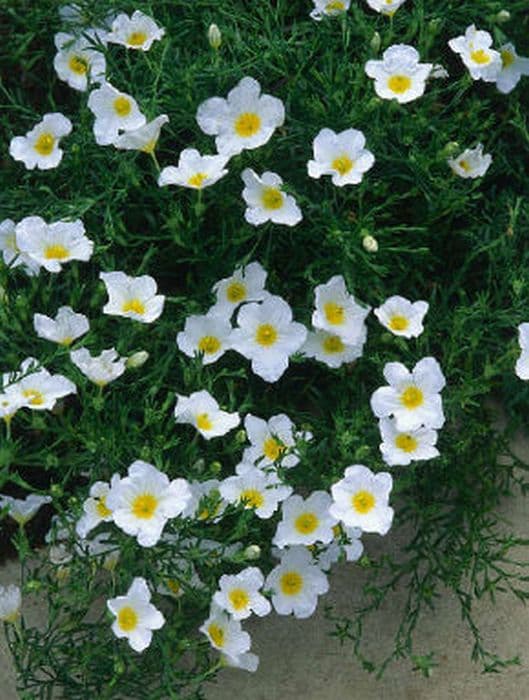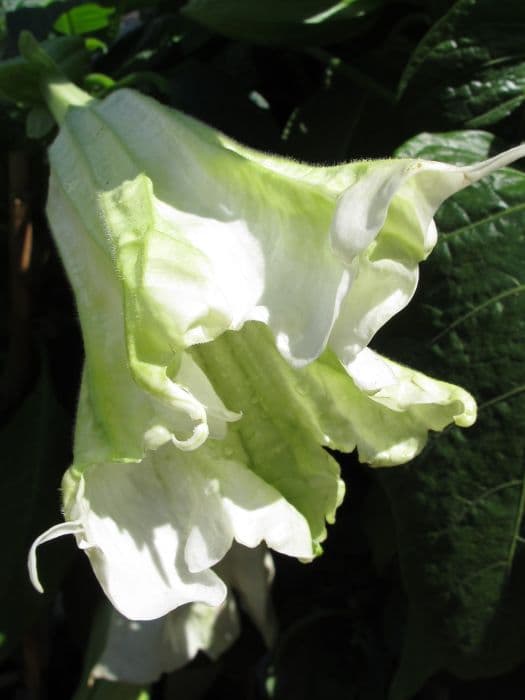Cupflower Nierembergia scoparia 'Mont Blanc'

ABOUT
Mont Blanc, known by its lovely appearance, is a captivating perennial with a bushy and mounding habit. Its foliage consists of narrow, lance-shaped leaves that are deep green, creating a dense and compact texture. The true allure of Mont Blanc comes from its exquisite flowers, which bloom profusely throughout the growing season. Each trumpet-shaped flower is pristine white, providing a stark and elegant contrast against the greenery. The petals are delicately flared and often display a slight creasing, giving them a subtle but distinctive texture. The center of the flowers usually features a light yellow to greenish throat, adding further depth and intrigue to the visual display. Mont Blanc exudes a clean and fresh aesthetic that makes it a favorite for garden borders, containers, and as a ground cover plant. With its full-bodied, continuous bloom, the plant adds a classic touch of serenity and charm wherever it is grown.
About this plant
 Names
NamesFamily
Solanaceae
Synonyms
Cupflower, White Cupflower, Mont Blanc Cupflower
Common names
Nierembergia scoparia 'Mont Blanc'.
 Toxicity
ToxicityTo humans
Cupflower is not widely known to be toxic to humans. However, as with many plants, it is generally advisable to avoid ingestion and to keep it out of reach of children who might accidentally consume plant parts. If any part is ingested and adverse symptoms appear, medical attention should be sought.
To pets
Cupflower is not widely recognized as toxic to pets. However, individual animals might have sensitivities or allergic reactions to plants not typically considered poisonous. If a pet ingests cupflower and exhibits signs of distress such as vomiting, diarrhea, or unusual behavior, it is recommended to consult a veterinarian.
 Characteristics
CharacteristicsLife cycle
Perennials
Foliage type
Evergreen
Color of leaves
Green
Flower color
White
Height
8 inches (20 cm)
Spread
12 inches (30 cm)
Plant type
Herb
Hardiness zones
7
Native area
Argentina
Benefits
 General Benefits
General Benefits- Attractive Flowers: Nierembergia scoparia 'Mont Blanc', commonly known as Cupflower, has beautiful white blooms that add aesthetic appeal to gardens.
- Low Maintenance: Cupflower is known for being easy to care for, making it suitable for novice gardeners.
- Drought Tolerance: Once established, Cupflower is relatively drought-tolerant, reducing the need for frequent watering.
- Pest Resistance: It has a natural resistance to many common garden pests, minimizing the need for pesticides.
- Continuous Blooming: Cupflower has a long blooming period, often from spring to frost, providing consistent garden interest.
- Compact Growth: Its compact growth habit makes it ideal for small gardens or borders without overshadowing other plants.
- Attracts Wildlife: It can attract butterflies and other pollinators, contributing to the health of the local ecosystem.
- Ground Cover: Cupflower can serve as an effective ground cover, suppressing weeds and reducing soil erosion.
 Medical Properties
Medical PropertiesThis plant is not used for medical purposes.
 Air-purifying Qualities
Air-purifying QualitiesThis plant is not specifically known for air purifying qualities.
 Other Uses
Other Uses- Nierembergia 'Mont Blanc' can be used to create contrasting textures in a miniature or fairy garden due to its delicate flowers and fine foliage.
- The plant's low and dense growth habit makes it ideal as a living mulch to suppress weeds around taller plants or in flower beds.
- Because of its modest size and ornamental appeal, 'Mont Blanc' serves as an excellent candidate for a "spiller" in hanging baskets or container gardens.
- Its drought tolerance and ability to thrive in various soil conditions make 'Mont Blanc' suitable for xeriscaping, helping to conserve water in landscaping.
- You can use cuttings from the plant to create intricate and small-scale topiary shapes for a whimsical touch to a garden.
- The white blooms of 'Mont Blanc' can be incorporated into moon gardens, where they will reflect moonlight and create nighttime interest.
- Plant 'Mont Blanc' along walkways or paths to outline the edges with its persistent blooming habit, as it is very foot-traffic tolerant.
- 'Mont Blanc' can play a role in sensory gardens, offering a soft texture and bright color that are pleasing to touch and view.
- Use the plant in educational settings such as schools or community gardens to demonstrate plant growth and lifecycle to students.
- In landscaping, 'Mont Blanc' can be utilized as a transitional plant, blending different garden styles or color themes seamlessly due to its neutral white flowers.
Interesting Facts
 Feng Shui
Feng ShuiThe Nierembergia is not used in Feng Shui practice.
 Zodiac Sign Compitability
Zodiac Sign CompitabilityThe Nierembergia is not used in astrology practice.
 Plant Symbolism
Plant Symbolism- Purity: 'Mont Blanc' is reminiscent of the pure white snow-capped peak of Mont Blanc in the Alps, symbolizing cleanliness and innocence.
- Peace: The color white commonly represents tranquility and calmness, suggesting that the Cupflower may embody peacefulness.
- Positive energy: The bright white blossoms of Cupflower are often associated with positive vibes and the ability to brighten up any space, metaphorically speaking.
 Water
WaterCupflower plants are best watered deeply and then allowed to dry out slightly between waterings. Generally, this means watering about once a week but adjust the frequency depending on weather conditions and soil drainage. Each watering should be thorough, providing about 1-2 gallons of water per plant, ensuring moisture reaches the roots. To avoid fungal diseases, water at the base of the plant to keep foliage dry. During hot spells or in particularly dry regions, check the soil moisture more frequently as additional watering may be necessary.
 Light
LightCupflower plants thrive in full sun to partial shade. They perform best when they get at least 6 hours of direct sunlight a day. Ideal placement is in an area where they are exposed to morning sun and some afternoon shade, particularly in hotter climates. Avoid deep shade conditions as this can impact the plant's flowering and overall vigor.
 Temperature
TemperatureCupflower plants prefer moderate temperatures and are hardy in a range from about 30°F to 90°F. They can survive light frosts but prolonged exposure to temperatures below freezing can damage or kill the plant. Ideal growing conditions are between 60°F and 70°F. Providing protection from extreme cold or excessive heat will benefit the plant's growth and blooming.
 Pruning
PruningPruning Cupflower plants helps to encourage bushier growth and more blooms. Lightly prune or pinch back the tips of the plants after the initial flush of flowers to promote a second blooming. This can be done every few weeks during the growing season. The best time for more significant pruning is early spring or after the plant has finished flowering, to tidy up the shape and remove any spent blooms or damaged stems.
 Cleaning
CleaningAs needed
 Soil
SoilCupflower (Nierembergia scoparia 'Mont Blanc') thrives in well-draining soil with a slightly acidic to neutral pH between 6.0 to 7.0. A mix of loamy soil, peat, and coarse sand or perlite is ideal to ensure good drainage and aeration.
 Repotting
RepottingCupflowers generally do not require frequent repotting and can be repotted every 2 to 3 years or when they outgrow their pots.
 Humidity & Misting
Humidity & MistingCupflower does best in moderate humidity levels but is quite adaptable and can tolerate the range of humidity levels typically found in home environments.
 Suitable locations
Suitable locationsIndoor
Provide bright light and occasional watering for indoor Cupflower.
Outdoor
Plant in sun to part shade, well-draining soil, water regularly.
Hardiness zone
7-10 USDA
 Life cycle
Life cycleThe Nierembergia scoparia 'Mont Blanc', commonly known as Cupflower, begins its life cycle as a seed, which when sown in warm soil typically during spring will germinate within a few weeks. After germination, the seedling emerges and starts developing its root system and foliage in a rosette pattern. As the plant matures, it enters a vegetative stage characterized by the growth of stems and leaves, and it forms a bushy, low mound. Further into the growing season, usually in late spring to early summer, the Cupflower starts to produce its characteristic white, trumpet-shaped flowers that continue to bloom throughout the summer until fall. After the flowering stage, if the pollinated flowers set seed, the plant enters a reproductive stage where it produces seed capsules that mature and eventually release seeds for the next generation. Finally, as an herbaceous perennial in suitable climates, the Cupflower will die back to the ground with the onset of winter's cold, to reemerge from its rootstock once the weather warms again in spring.
 Propogation
PropogationPropogation time
Spring to Summer
Propogation: The most popular method of propagating Nierembergia scoparia 'Mont Blanc', also known as Cupflower, is via seed. Propagation time often begins in late winter to early spring, as this allows for ample growth time before planting out after the frost. Seeds can be sown in seed trays or pots filled with well-draining soil mix. They should be lightly covered with soil and kept consistently moist but not waterlogged. To encourage germination, maintain a temperature of around 70 degrees Fahrenheit (21 degrees Celsius). Seedlings usually appear in 14 to 21 days, after which they can eventually be transplanted to individual pots when they are large enough to handle and eventually moved outdoors when the risk of frost has passed.


![Calibrachoa [Aloha Classic Tiki Hot Pink]](/_next/image?url=https%3A%2F%2Fplants-admin.emdemapps.com%2Fimages%2Fplants%2F%2Fimages%2F604b599a202f7.png&w=640&q=75)
![Calibrachoa [Calibasket Pink Doll]](/_next/image?url=https%3A%2F%2Fplants-admin.emdemapps.com%2Fimages%2Fplants%2F%2Fimages%2F604b5cb88b9da.png&w=640&q=75)
![Calibrachoa [Can-can Cherry Blossom]](/_next/image?url=https%3A%2F%2Fplants-admin.emdemapps.com%2Fimages%2Fplants%2F%2Fimages%2F604b536ae09db.png&w=640&q=75)
![Calibrachoa [Can-can Coral Reef]](/_next/image?url=https%3A%2F%2Fplants-admin.emdemapps.com%2Fimages%2Fplants%2F%2Fimages%2F604b53dd3f1ff.png&w=640&q=75)
![Calibrachoa [Can-can Neon Pink]](/_next/image?url=https%3A%2F%2Fplants-admin.emdemapps.com%2Fimages%2Fplants%2F%2Fimages%2F604b54e33a0d2.png&w=640&q=75)
![Calibrachoa [Chameleon Blueberry Scone]](/_next/image?url=https%3A%2F%2Fplants-admin.emdemapps.com%2Fimages%2Fplants%2F%2Fimages%2F604b6507a5262.png&w=640&q=75)
![Calibrachoa [Colibri Fuchsia]](/_next/image?url=https%3A%2F%2Fplants-admin.emdemapps.com%2Fimages%2Fplants%2F%2Fimages%2F604b5f520fec3.png&w=640&q=75)
![Calibrachoa [Hula Lavender]](/_next/image?url=https%3A%2F%2Fplants-admin.emdemapps.com%2Fimages%2Fplants%2F%2Fimages%2F604b56807ba71.png&w=640&q=75)